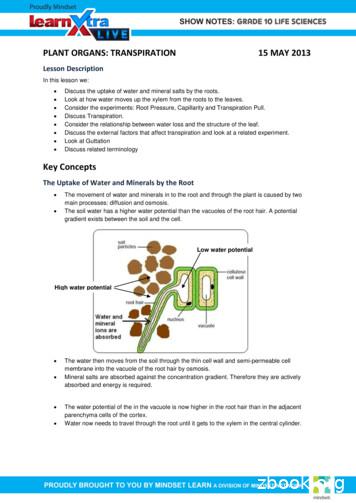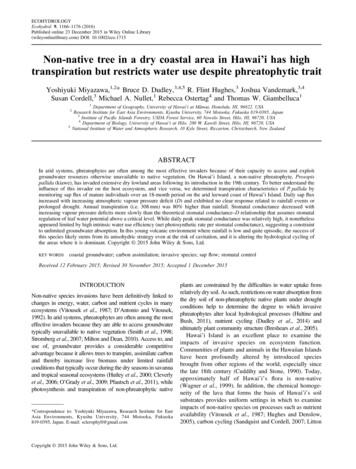Transpiration In Gas Exchange Multicellular Plants Transport In Plants
Transport in plantsTransport andTranspiration inMulticellular Plants H2O & minerals Sugars Gas exchangeTransport in plantsTransport in plants H2O & minerals H2O & minerals transport in xylemtranspiration evaporation, adhesion &cohesion negative pressure evaporation, adhesion &cohesion negative pressure Sugars Gas exchangetransport in xylemtranspiration Sugars transport in phloembulk flow Calvin cycle in leaves loadssucrose into phloem positive pressure Gas exchangeTransport in plantsTransport in plants H2O & minerals Physical forces drive transport at different scales transport in xylemtranspiration from environment into plant cells Sugars transport of H2O & solutestransport in phloembulk flow Gas exchangeinto root hairs respiration O2 in; CO2 out roots exchange gaseswithin air spaces in soilshort-distance transport from cell to cellphotosynthesis loading of sugar from CO2 in; O2 out stomates cellularphotosynthetic leaves intophloem sieve tubes long-distance transport transport in xylem & phloemthroughout whole plantWhy does over-watering kill a plant?1
Cellular transportShort distance (cell-to-cell) transport Active transport Compartmentalized plant cells cell wallcell membrane vacuole solutes are movedinto plant cells viaactive transportcentral role ofproton pumpsCotransport with H ions cytosol Movement from cell to cellmove through cytosol plasmodesmata junctions connectcytosol of neighboring cells symplastproton pumpsmove through cell wall continuum of cell wallconnecting cell to cellapoplastsymplast apoplastRoutes from cell to cellLong distance transport Bulk flow Moving water & solutes between cells transmembrane route repeated crossing of plasma membranes symplast route move from cell to cell within cytosol movement of fluid driven by pressure flow in xylem tracheids & vessels negative pressure transpiration creates negative pressure pulling slowest route but offers more controlapoplast routexylem sap upwards from roots move through connected cell wall without crossing cell membrane flow in phloem sieve tubes positive pressure loading of sugar from photosynthetic leaf cells fastest route but never enter cellgenerates high positive pressure pushingphloem sap through tubeMovement of water in plantscells are flaccidplant is wilting Water relations inplant cells is basedon water potential osmosis throughaquaporins transport proteins water flows fromhigh potential tolow potentialWater & mineral uptake by roots Mineral uptake by root hairs dilute solution in soilactive transport pumps this concentrates solutes ( 100x) in root cells Water uptake by root hairs flow from high H2O potential to low H2O potentialcreates root pressurecells are turgid2
Root anatomydicotmonocotRoute water takes through rootControlling the route of water in root Water uptake by root hairs Endodermis a lot of flow can be through cell wall routeapoplasty cell layer surrounding vascular cylinder of rootlined with impervious Casparian stripforces fluid throughselective cell membrane& into symplast filtered &forced intoxylem vesselsMycorrhizae increase absorption Symbiotic relationship between fungi & plant Mycorrhizaesymbiotic fungi greatly increases surface area forabsorption of water & minerals (phosphates)increases volume of soil reached by plantincreases transport to host plant3
Ascent of xylem “sap”May apples and MycorrhizaeTranspiration pull generated by leafObligate mutualism!Rise of water in a tree by bulk flow Transpiration pull adhesion & cohesion brings water &minerals to shoot H bondingwater in a day this loss must be balancedwith plant’s need for CO2 for photosynthesishigh in soil low in leaves a corn plant transpires 125 L of water in agrowing season Root pressure push always a compromise betweenphotosynthesis & transpiration leaf may transpire more than its weight in Water potential Control of transpiration Stomate functiondue to flow of H2Ofrom soil to root cellsupward push ofxylem sapFunction of Guard CellsStomatal transpirationCuticlePreventswater lossMesophyllSite ofphotosynthesisHow do the guard cellsreact to the availabilityof water? Dry – guard cellsCLOSE lots of H2O – guardcells OPENCuticleStomataOpenings allow gasesand water to move inand out of leafGuard cellsOpen and closethe stomata4
Characteristics of guard cellsRegulation of stomates Microfibril mechanism guard cells attached at tipsmicrofibrils in cell walls elongate causing cells toarch open open stomate shorten close when wateris lost Ion mechanism uptake of K ions by guardcells proton pumps water enters by osmosis guard cells become turgid loss of K ions by guard cells water leaves by osmosis guard cells become flaccid Abscisic acid can also closestomatesRegulation of stomates Other cues light trigger blue-light receptor in plasma membrane of guard cellstriggers ATP-powered proton pumps causing K uptake stomates open depletion of CO2 circadian rhythm internal “clock” CO2 is depleted during photosynthesis (Calvin cycle)Stomatal Control Stomates fill with water to open and emptyof water (become flaccid) to close Overall, stomata import solutes when theyneed to open Higher solute concentration lower waterpotential more negative water flows in The opposite is true for closing Several factors influence these openingsand closings automatic 24-hour cycleLight Stomata of most plant open in the day and close at night CAM plants are theopposite (desertadaptation)Stomata opening aresensitive to red light andblue light Blue light is more effective-stimulates opening byblue-light receptorzeaxanthin. Allows stomata to be openin light that is conducive tophotosynthesisTemperature Stomatal aperture increases withtemperature 20- 30 is optimal—too hotmeans too much evaporation andthe plant can wither, so stomataclose5
CO2 Low CO2 concentrationWater content Stomata openpromotes stomatalopening when the leafcontainsenough water.When there is awater shortage,they close.Necessary so enoughCO2 is available forphotosynthesis High CO2 concentrationinhibits stomatal opening CO2 acidifies the guardcellHormonesHelps preventwilting fromovertranspirationTranspiration Rates Transpiration depends on concentration gradients Cytokinins (CTKs) stimulatestomatal opening Abscisic Acic (ABA) stimulatesstomatal closing Both affect overall soluteconcentration in the guard cells,causing water to move in or outFactors affecting rate oftranspiration Many factors affect this water vapor concentration gradientAffect overall rate of transpirationin the same way that mass flow doesThe drivingforce oftranspiration isthe “vaporpressuregradient.” Thisis the differencein vaporpressurebetween theinternal spacesin the leaf andthe atmospherearound the leafLight Plants transpire more rapidly in the light thanin the dark.Light stimulates theopening of the stomataLight also increasestemperature of leaf6
Temperature Plants transpire more rapidly athigher temperatures becausewater evaporates more rapidly asthe temperature rises.Wind When a breeze is present, thehumid air is carried away andreplaced by drier airHumidity Whenthesurrounding air is dry,diffusion of water outof the leaf goes onmore rapidly.PotometerSoil Water A plant cannot continue to transpire rapidlyif its water loss is not made up byreplacement from the soil. If absorption of water by the roots is therate of transpiration loss of turgor occurs stomata close. Reduces the rate of transpiration. If this extends to the rest of the leaf andstem, the plant wilts.Translocation via phloem Loading of sucrose into phloemflow through symplast viaplasmodesmata active cotransport of sucrosewith H protons Pressure flow in sievetubes Water potential gradient “source to sink” flow direction of transport inphloem is variable proton pumps Can be simultaneously up and down indifferent tubes, but only one directionin any given tube can flow1m/hrsucrose flows into phloem sievetubewater flows in from xylem vessels increase in pressure due toincrease in H2O causes flowWhat plant structures are sources & sinks?7
Putting it all togetherMaple sugaring Obtaining raw materials sunlight CO2 H2O nutrients leaves solar collectors stomates gas exchange uptake from roots uptake from rootsTracheid (xylem cell)Sieve tubeelementTracheidLignified walls provide structureto withstand negative pressureof transpirationVessel elementVesselelement(xylem cell)Sieve tubeelementPhloemtissue*Vessel elements have holesbetween them to allowunimpeded flowMonocot RootCross Section (cs)*Sieve plates maintainpositive pressure in tubeelements*Thin cytoplasm, no nucleiin sieve tubesCompanioncellSite of active loading ofphloem—H pumped intoapoplast, flow back intocompanion cellcotransporting sucrose8
Dicot RootCross Section (cs)Monocot StemDicot StemMonocot Leaf Midribshowsvasculartissue: Canyou ID? Leaves haveparallelveins(visible here) Do you seethe stomata?Dicot Leaf These leaveshave a moreobvious midrib (centralvein)Any Questions? Veins areperpendicularto the centralvein.9
Transpiration Rates Transpiration depends on concentration gradients in the same way that mass flow does The driving force of transpiration is the "vapor pressure gradient." This is the difference in vapor pressure between the internal spaces in the leaf and the atmosphere around the leaf Factors affecting rate of transpiration
Transpiration occurs through young or mature stem is called as Cauline transpiration. Depending upon the plant surface, transpiration is classified into three types: Water vapour diffuses out through minute pore (stomata) present in soft aerial part of plant is known as Stomatal Transpiration Stomatal Transpiration
transpiration rate was higher in HP than that in SDJ. Considering higher CO 2 exchange rate together with lower transpiration in SDJ indicated that some other cultivars rice genetic resources could use to enhance rice yield potential and water use efficiency in an irrigated rice system. Keywords: photosynthesis, red light, rice, transpiration .
Transpiration Pull This is the main force that causes water to move up the stem against the force of gravity. Transpiration is the loss of water in the form of water vapour through the aerial parts of a plant through stomata Experiment to demonstrate that transpiration occurs through the aerial parts of a plant
Global Reference Evapo-Transpiration (Global-ET0) Potential Evapo-Transpiration (PET) is a measure of the ability of the atmosphere to remove water through Evapo-Transpiration (ET) processes. Among several equations to estimate PET, a FAO application of the Penman-Monteith equation (Allen et al. 1998), here referred as FAO-
transpiration rates increase in response to rainfall events, allowing higher transpiration rates than the level that is expected to be achieved under isohydric stomatal control (Oren et al., 1999). In this study, we monitored the sap flux of P.pallida stands with ample access to shallow groundwater and compared the annual transpiration rate .
schemes such as film and transpiration cooling will have to be utilized. Theoretically transpiration cooling is superior to film cooling as shown in reference 4, provided the oxidation problems described below can be over- come. Also good creep life can be accomplished with transpiration cooled blade
2.3.3. Transpiration rate 10 2.3.4. Soil water status 11 2.4. Theoretical Background 12 2.4.1. Determination of tree transpiration based on sap-flow measurement by the heat-pulse technique 12 2.4.2. Micro-meteorological methods for estimating transpiration of an avocado orchard 15 2.4.2.1.
locked AutoCAD .DWG format electronically with a relevant index/issue sheet. Estates and Facilities currently use AutoCAD 2016. Drawings supplied on CD should be clearly labelled with the Project details, date and version of AutoCAD used. Drawings produced using BIM software (such as Revit) must be exported into AutoCAD DWG format before issue. The University will also require any original BIM .























